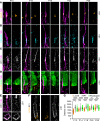Gene augmentation of LCA5-associated Leber congenital amaurosis ameliorates bulge region defects of the photoreceptor ciliary axoneme
- PMID: 37071472
- PMCID: PMC10322687
- DOI: 10.1172/jci.insight.169162
Gene augmentation of LCA5-associated Leber congenital amaurosis ameliorates bulge region defects of the photoreceptor ciliary axoneme
Abstract
Leber congenital amaurosis (LCA) is a group of inherited retinal diseases characterized by early-onset, rapid loss of photoreceptor cells. Despite the discovery of a growing number of genes associated with this disease, the molecular mechanisms of photoreceptor cell degeneration of most LCA subtypes remain poorly understood. Here, using retina-specific affinity proteomics combined with ultrastructure expansion microscopy, we reveal the structural and molecular defects underlying LCA type 5 (LCA5) with nanoscale resolution. We show that LCA5-encoded lebercilin, together with retinitis pigmentosa 1 protein (RP1) and the intraflagellar transport (IFT) proteins IFT81 and IFT88, localized at the bulge region of the photoreceptor outer segment (OS), a region crucial for OS membrane disc formation. Next, we demonstrate that mutant mice deficient in lebercilin exhibited early axonemal defects at the bulge region and the distal OS, accompanied by reduced levels of RP1 and IFT proteins, affecting membrane disc formation and presumably leading to photoreceptor death. Finally, adeno-associated virus-based LCA5 gene augmentation partially restored the bulge region, preserved OS axoneme structure and membrane disc formation, and resulted in photoreceptor cell survival. Our approach thus provides a next level of assessment of retinal (gene) therapy efficacy at the molecular level.
Keywords: Cell Biology; Gene therapy; Genetics; Molecular genetics; Retinopathy.
Figures







Similar articles
-
Disruption of intraflagellar protein transport in photoreceptor cilia causes Leber congenital amaurosis in humans and mice.J Clin Invest. 2011 Jun;121(6):2169-80. doi: 10.1172/JCI45627. Epub 2011 May 23. J Clin Invest. 2011. PMID: 21606596 Free PMC article.
-
Knocking out lca5 in zebrafish causes cone-rod dystrophy due to impaired outer segment protein trafficking.Biochim Biophys Acta Mol Basis Dis. 2019 Oct 1;1865(10):2694-2705. doi: 10.1016/j.bbadis.2019.07.009. Epub 2019 Jul 23. Biochim Biophys Acta Mol Basis Dis. 2019. PMID: 31348989
-
Screening of a large cohort of leber congenital amaurosis and retinitis pigmentosa patients identifies novel LCA5 mutations and new genotype-phenotype correlations.Hum Mutat. 2013 Nov;34(11):1537-1546. doi: 10.1002/humu.22398. Epub 2013 Sep 17. Hum Mutat. 2013. PMID: 23946133 Free PMC article.
-
Leber congenital amaurosis: genes, proteins and disease mechanisms.Prog Retin Eye Res. 2008 Jul;27(4):391-419. doi: 10.1016/j.preteyeres.2008.05.003. Epub 2008 Jun 1. Prog Retin Eye Res. 2008. PMID: 18632300 Review.
-
Gene and Cell Therapy for AIPL1-Associated Leber Congenital Amaurosis: Challenges and Prospects.Adv Exp Med Biol. 2019;1185:97-101. doi: 10.1007/978-3-030-27378-1_16. Adv Exp Med Biol. 2019. PMID: 31884595 Review.
Cited by
-
iU-ExM: nanoscopy of organelles and tissues with iterative ultrastructure expansion microscopy.Nat Commun. 2023 Nov 30;14(1):7893. doi: 10.1038/s41467-023-43582-8. Nat Commun. 2023. PMID: 38036510 Free PMC article.
-
Ciliopathy-associated protein, CEP290, is required for ciliary necklace and outer segment membrane formation in retinal photoreceptors.bioRxiv [Preprint]. 2025 Jan 20:2025.01.20.633784. doi: 10.1101/2025.01.20.633784. bioRxiv. 2025. PMID: 39896654 Free PMC article. Preprint.
-
Small molecule treatment alleviates photoreceptor cilia defects in LCA5-deficient human retinal organoids.Acta Neuropathol Commun. 2025 Feb 11;13(1):26. doi: 10.1186/s40478-025-01943-y. Acta Neuropathol Commun. 2025. PMID: 39934925 Free PMC article.
-
Glutamylation imbalance impairs the molecular architecture of the photoreceptor cilium.EMBO J. 2024 Dec;43(24):6679-6704. doi: 10.1038/s44318-024-00284-1. Epub 2024 Nov 11. EMBO J. 2024. PMID: 39528655 Free PMC article.
-
Clinical and Molecular Aspects of C2orf71/PCARE in Retinal Diseases.Int J Mol Sci. 2023 Jun 26;24(13):10670. doi: 10.3390/ijms241310670. Int J Mol Sci. 2023. PMID: 37445847 Free PMC article. Review.
References
-
- Osterberg G. Topography of the layer of rods and cones in the human retina. Acta Ophthalmol Suppl. 1935;6:1–103.
Publication types
MeSH terms
Substances
Supplementary concepts
LinkOut - more resources
Full Text Sources
Research Materials

